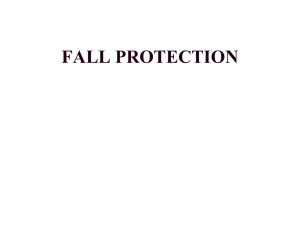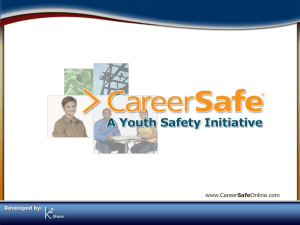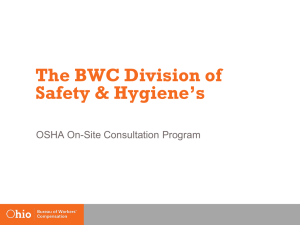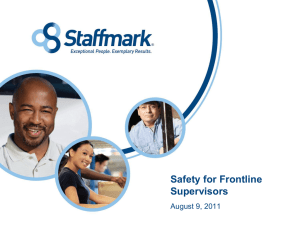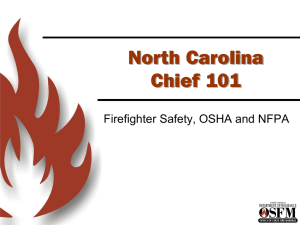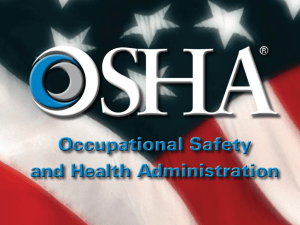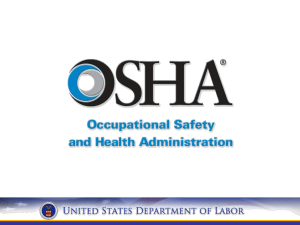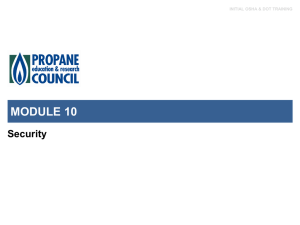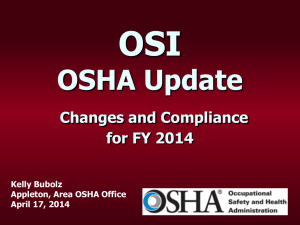Guarding Wall Openings
advertisement
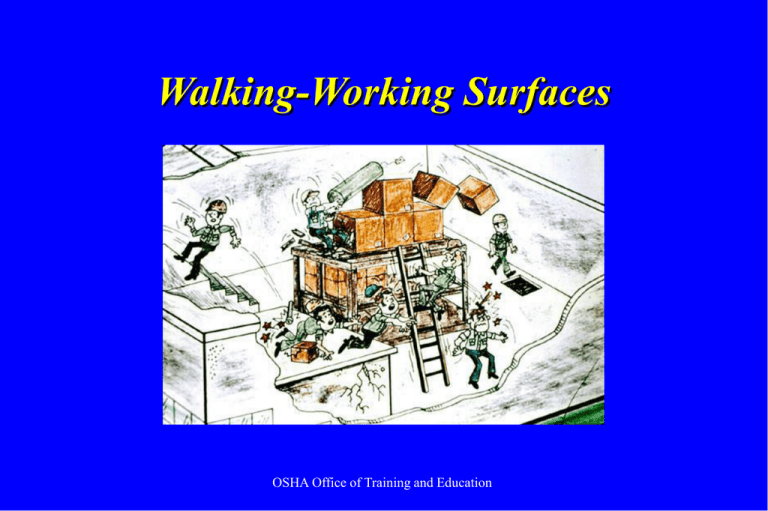
Walking-Working Surfaces OSHA Office of Training and Education Introduction Slips, trips and falls constitute the majority of general industry accidents This discussion covers some of the most frequentlyoccurring serious hazards involving OSHA’s walkingworking surfaces standards OSHA Office of Training and Education General Requirements Housekeeping All workplaces must be kept clean and orderly and in a sanitary condition Every workroom floor must be maintained as clean and dry as possible OSHA Office of Training and Education General Requirements Aisles and Passageways Keep clear and in good repair with no obstruction across or in aisles that could create a hazard Permanent aisles and passageways must be appropriately marked Aisles must be sufficiently wide where mechanical handling equipment is used OSHA Office of Training and Education General Requirements Covers and Guardrails Covers and/or guardrails must be provided to protect employees from the hazards of open pits, tanks, vats, ditches, and the like. OSHA Office of Training and Education General Requirements Floor Loading Protection Load rating plates must be marked on plates and conspicuously posted No load must be placed on any floor or roof that is greater than its load rating limit OSHA Office of Training and Education Guarding Floor and Wall Openings and Holes Definitions Floor opening. An opening measuring 12 inches or more in its least dimension, in any floor, platform, pavement, or yard, through which persons may fall. Floor hole. An opening measuring less than 12 inches but more than 1 inch in its least dimension, in any floor, platform, pavement or yard, through which materials but not persons may fall. OSHA Office of Training and Education Guarding Floor and Wall Openings and Holes Definitions (cont’d) Wall opening. An opening at least 30 inches high and 18 inches wide, in any wall or partition, through which persons may fall. Wall hole. An opening less than 30 inches but more than 1 inch high, of unrestricted width, in any wall or partition. OSHA Office of Training and Education Guarding Floor and Wall Openings and Holes Definitions (cont’d) Standard railing. Consists of top rail, mid rail, and posts, a vertical height of 42 inches nominal from the upper surface of top rail to floor level. Nominal height of mid rail is 21 inches. Standard toeboard. 4 inches nominal in vertical height, with not more than ¼-inch clearance above floor level. OSHA Office of Training and Education Guarding Stairway Floor Openings Must be guarded by a standard railing on all exposed sides (except at stairway entrance). OSHA Office of Training and Education Guarding Ladderway Floor Openings Must be guarded by a standard railing with toeboard on all exposed sides (except at entrance) Swinging gate or offset required so that a person cannot walk directly into the opening OSHA Office of Training and Education Guarding Wall Openings Every wall opening from which there is a drop of more than 4 feet must be guarded. OSHA Office of Training and Education Guarding Temporary Floor Openings Must have standard railings or be constantly attended by someone. OSHA Office of Training and Education Guarding Open-Sided Floors and Platforms Every open-sided floor or platform 4 feet or more above adjacent floor or ground level must be guarded by a standard railing (or equivalent) on all open sides, except where there is an entrance to a ramp, stairway, or fixed ladder. A toeboard is required wherever, beneath the open sides: Persons can pass, There is moving machinery, or There is equipment with which falling materials could create a hazard. OSHA Office of Training and Education Guarding Platforms OSHA Office of Training and Education Guarding Open-Sided Floors, Walkways, Platforms, and Runways Regardless of height, open-sided floors, walkways, platforms, or runways above or adjacent to dangerous equipment, pickling or galvanizing tanks, degreasing units, and similar hazards must be guarded with a standard railing and toeboard. OSHA Office of Training and Education Guarding Stairways Every flight of stairs with four or more risers must have standard stair railings or standard handrails. OSHA Office of Training and Education Portable Ladders Must withdraw defective ladders from service and tag or mark "Dangerous, Do Not Use" Ladders used to gain access to a roof or other area must extend at least 3 feet above the point of support Ladders must never be used in a horizontal position as scaffolds or work platforms Metal ladders must never be used near electrical equipment OSHA Office of Training and Education Summary Slips, trips, and falls constitute the majority of general industry accidents They cause 15% of all accidental deaths, and are second only to motor vehicles as a cause of fatalities OSHA’s standards for walking and working surfaces apply to all permanent places of employment, except where only domestic, mining, or agricultural work is performed OSHA Office of Training and Education


